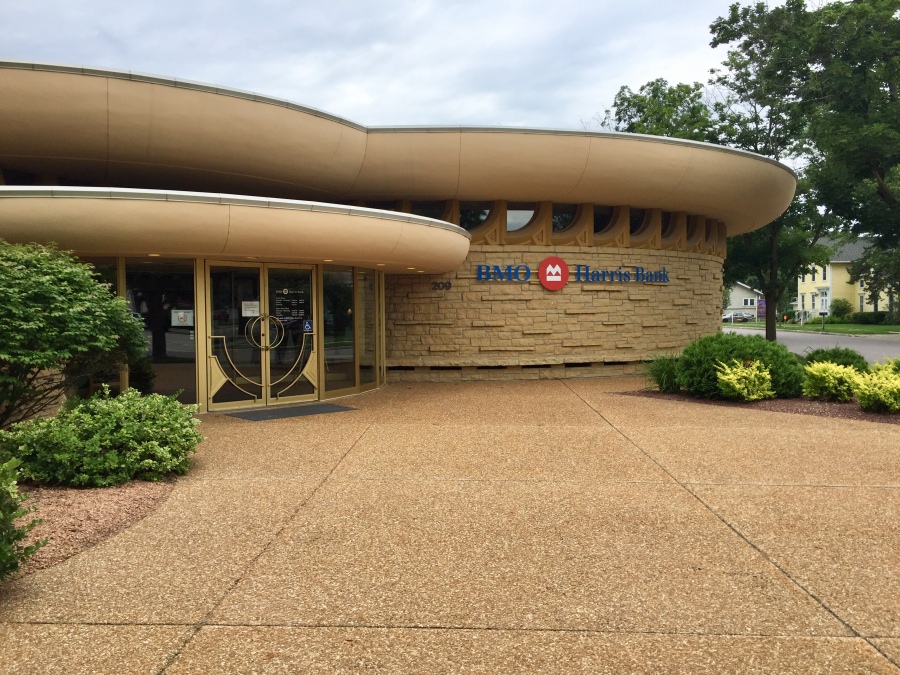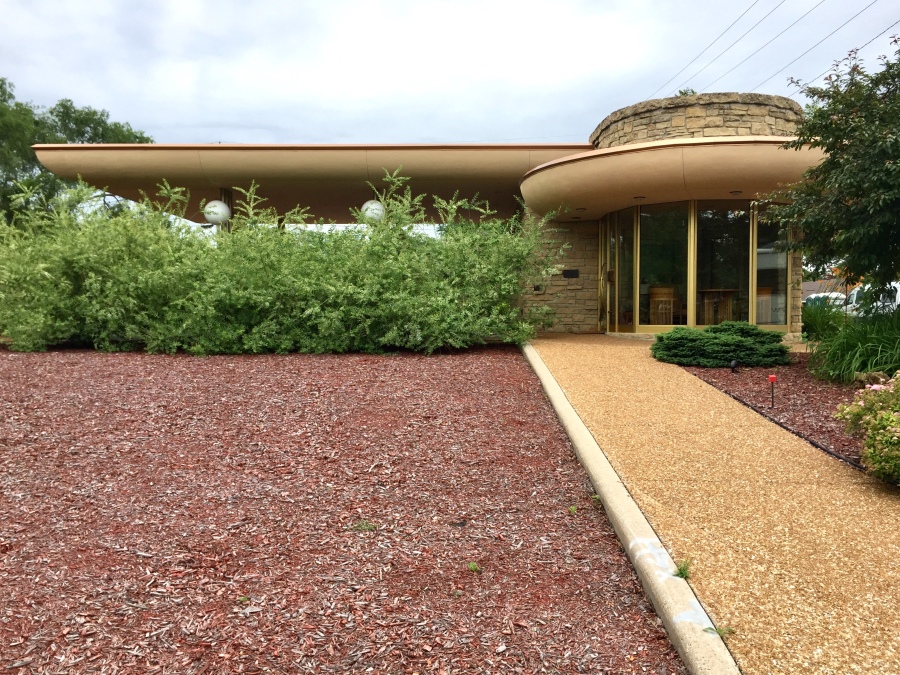
Frank Lloyd Wright spent much of his childhood near Spring Green, Wisconsin, and lived there off and on from the 1911 construction of Taliesin, his Wisconsin estate, until his death in 1959. Despite Wright’s mixed relationship with the locals, you don’t have to look far to see his influence on local architecture. And I’m not referring to the popular American Foursquare and Ranch style houses ubiquitous in the rural Midwest (both informed by Wright’s ideas). In Spring Green, you will find an eye-catching bank right in the middle of town that is nothing short of Wrightian. It was not, however, designed by Wright! What’s the story? Read on:
The Bank of Spring Green, now a BMO Harris Bank, was designed by William Wesley Peters and completed in 1972. Peters began as an apprentice to Wright in 1932 and served as a project architect and structural engineer for a number of Wright’s most famous buildings, including the Guggenheim (1959), the Johnson Wax buildings (1936-1944), and Fallingwater (1936). Upon Wright’s death in 1959, Peters became the chairman of Taliesin Associated Architects. Peters had several years of his own architecture practice but spent much of his career promoting the work of Frank Lloyd Wright and was chairman of the Frank Lloyd Wright Foundation upon his death in 1991.
The natural materials and patterns of concentric circles used in the Bank of Spring Green reflect Wrightian ideas and remind of buildings like the Marin County Civic Center. An adjacent annex features a drive-through with a curved roof, which unfortunately has become overgrown with vegetation in recent years. But, even the vegetation surrounding the annex cannot hide the intriguing character of these buildings. The curves and warm colored, natural materials are inviting and beckon passersby to step closer, to come right up to the front door.






Sources and Further Reading:
The Bank of Spring Green has made it to a number of architecture and travel sites, including: claass HAUS, Roadside Architecture, and the Lower Wisconsin State Riverway Board.
For more information about Peters, you can read the New York Times obituary and check out the archive of historic photos and documents at the Wright Library.
You can explore more Wisconsin and Frank Lloyd Wright sites by heading over to my Explore page. Know of one I haven’t visited? I’d love to hear about it! Leave a comment or send me a note.



This is an interesting building to me, and I do appreciate many of its attributes. I am still pondering that flying saucer roofline, though; it almost seems like it screams “too much” for the double dipping over the entrance.
LikeLike
I agree about the roofline!
My first impression on the building was like retro computer game kind of building. I think it’s a facade material combined with window detail.
Thank you for writing about this building, have never heard about it before!
LikeLiked by 1 person
I like the retro computer game comparison! The window detail is particularly interesting and maybe a little out of place (though similar to some of Wright’s work). This building does make you think!
LikeLike
Yes, it is a bit dramatic and very Space Age-y, especially the roof! It doesn’t tie in with the landscape as nicely as Wright’s buildings tend to. I wonder what Wright would have thought of it.
LikeLike
Great angles in the photography, and the Title ‘Spaces’ just fits in well with the landscape and building.
LikeLike
Thank you! This was a particularly fun one to photograph. A good architect creates a good photography challenge.
LikeLike
Absolutely outstanding!
Oh, what a pleasure it would be to have more builders care this much.
LikeLike
Isn’t it fantastic? We definitely have gone far too simplistic in the last few decades. One can hope the scale will start tipping the other way again soon.
LikeLike
Always enjoy your architectural travels. Thanks. Keep on keepin’ on.
LikeLike
Thanks!! Always more things to see!
LikeLike
Love reading your blog!
What’s up with the barren landscaping in the second to last photo though?
LikeLike
Ugh that landscaping makes me so sad! That was where the drive-through used to be. There’s a picture of how it used to look here: http://www.roadarch.com/modarch/wibank2.html
LikeLike
Wonderfully compiled article. Thanks a sharing a building that is not very popular among Architecture students.
LikeLike
Thank you! Taliesin represents an interesting point of Wright’s career—after the Prairie style but before his more modern works. It’s a fascinating and beautiful place!
LikeLiked by 1 person
true that!
LikeLike
Great article. I remember my father and I stumbling across this bank when we were in Spring Green on a cross-country trip in 1992.
As a side note, William Wesley Peters was married to one of Joseph Stalin’s daughters in the early 70’s.
LikeLike
Thanks! Spring Green is a cool little town. I did turn up that interesting snippet about Peters in my research–and that his first wife was Olgivanna’s daughter! Fascinating historical tangent.
LikeLike